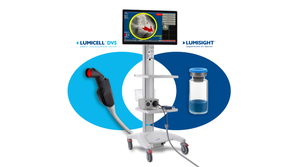October 19, 2016
Harvard Medical School and MIT researchers have created a stretchy optical fiber made from hydrogel that can be implanted into the body to deliver therapeutic pulses of light--as well as light up to signal signs of disease.
Kristopher Sturgis
 A new biocompatible optical fiber made from hydrogels boasts highly stretchable properties, enabling it to bend and twist with the body upon implantation. The new technology is thought to have potential as a long-lasting implant that could be used in optogenetics--a field of study that deals with light to activate cells in the body, specifically neurons in the brain.
A new biocompatible optical fiber made from hydrogels boasts highly stretchable properties, enabling it to bend and twist with the body upon implantation. The new technology is thought to have potential as a long-lasting implant that could be used in optogenetics--a field of study that deals with light to activate cells in the body, specifically neurons in the brain.
"These flexible, biocompatible hydrogel fibers may be implanted in the brain to deliver light to stimulate neurons, enhance memory functions, or inhibit disordered signals," says Seok-Hyun Yun, associate professor at Harvard Medical School and designer of the optical fiber. "The highly-stretchable fibers may also be used to fabricate a strain mapping fabric-type sensor that is wearable or implantable."
This means that in addition to providing a new tool for optogenetics, the optical fibers could also hold potential as a sensor technology that could sense when and where it was being stretched. To test this, the group decided to inject the fiber with red, green, and blue organic dyes placed at specific points along the length of the fiber. They found that when shining a laser on a specific spot in the fiber, the amount of light absorbed by the dye directly relates to how much the fiber was being stretched.
Essentially, this meant that when you stretch a certain spot of the fiber, the dimensions of that spot on the fiber change, distorting the amount of light that region of the fiber absorbs -- effectively serving as a sensor of strain technology. Yun says that because the technology was designed to be biocompatible, it could be used as both a wearable device, or implanted directly into the body without triggering any harmful immune responses.
"Conventional fibers are made of glass, which are stiff and fragile," Yun said. "These new hydrogel fibers are biocompatible, flexible, and elastic, just like soft tissues. Therefore, they can be implanted for long term use without damaging the tissue or causing harmful immune reactions."
While such applications may be far off, Yun says the group's next step is to begin preclinical models and prepare the technology for long term applications.
"Our next step is to reduce the propagation loss further," he says, "to test and improve the long term stability of the fibers in vivo, and demonstrate their applications in preclinical animal models."
Kristopher Sturgis is a contributor to Qmed.
Like what you're reading? Subscribe to our daily e-newsletter.
Maureen Kingsley is a contributor to Qmed.
Like what you're reading? Subscribe to our daily e-newsletter.
About the Author(s)
You May Also Like


